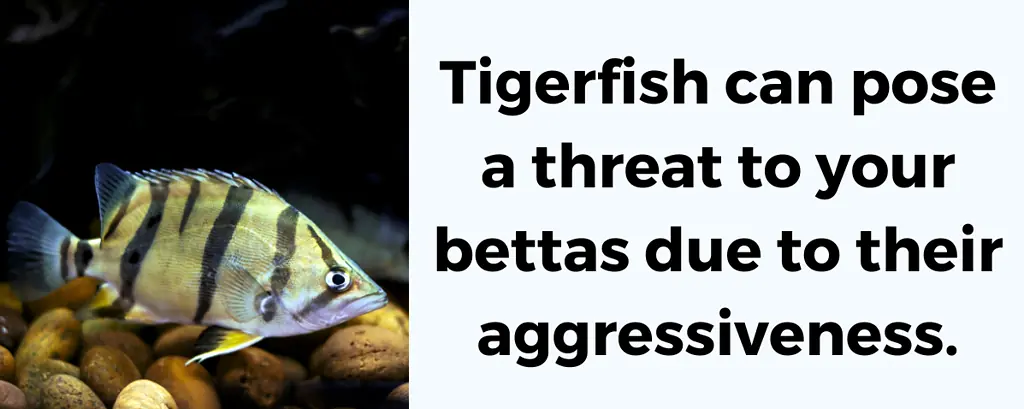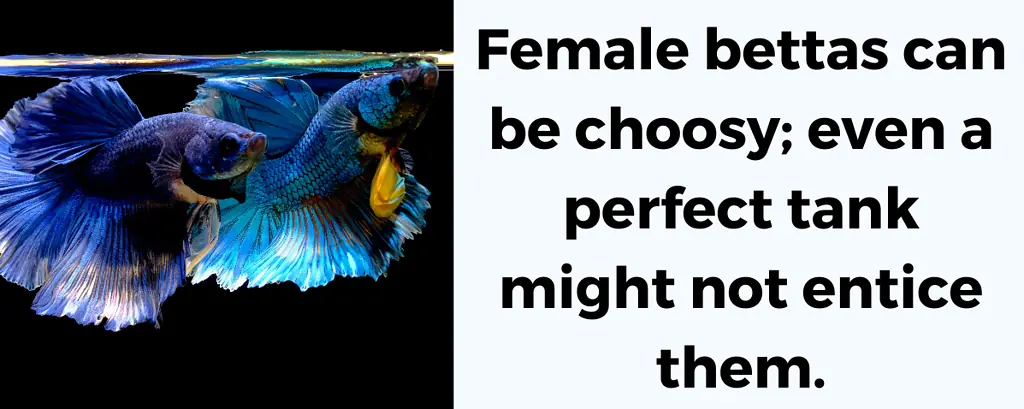Welcome to the Rosetail Betta, a breathtaking type of Betta with a tail fin reminiscent of a blooming rose.
Its iridescent colors and flamboyant flares make it a crowd-pleaser in any aquarium.
For anyone looking to sharpen their Betta care skills, it’s important to master the art of fish care, especially when dealing with unique varieties like the Rosetail.
While general Betta care guides serve as a fantastic starting point, understanding the nuanced differences between breeds separates a content Betta from a downtrodden one.
So get ready to delve into your Betta care guide and embark on the journey to become the ultimate Rosetail Betta parent.
Why? As the tried and true fishkeeping proverb states: “Every Betta is as unique as the tail fin that trails gracefully behind them.”
Table of Contents
Physical Characteristics of Rosetail Betta

Appearance
Fin Shape and Size
The Rosetail Betta, aptly named for the rose-like appearance of its betta fins, owes its distinct elegance to a combination of genetics and selective breeding.
Imagine ethereal lace underwater, fanning out into a botanical ballet.
This picture perfectly depicts the variety of betta known as the Rosetail.
The edges of their contoured rosetail betta fins split and intertwine, creating a grand flourish akin to a rose in full bloom.
Color Variants
Imagine a Monet painting in an aquarium fish setting: that’s the captivating allure of this Betta Splendens, also known as the Rosetail Betta.
Their genetic diversity paints countless color variations spanning from sultry rubies to ethereal, shimmering blues.
Commonly seen in beautiful shades of blue, red, and all sorts of marbling in between, these beautiful fish bring unexpected charm.
With plenty of varieties of bettas to choose from, they’ve earned a top spot on the list for fish enthusiasts.
Their presence isn’t just an addition; it’s a delightful spectacle that electrifies any home aquarium.
Male vs. Female Differences

Size Differences
Size does matter for Betta fish. Male Rosetail Bettas are typically larger, roughly 2.5 to 3 inches, while females average between 2 to 2.5 inches.
This doesn’t highly influence tank setups or attitudes. But remember, even small needs space and care!
Coloration and Fin Shape
Siamese Fighting Fish, better known as Bettas, have radiant colors and royally majestic fins – truly the water-treading equivalent of a peacock!
As a result of creative genetic curation through selective breeding, they boast various fascinating betta tail types.
On the other hand, while still utterly charming, our lady Bettas presents with more subdued shades and subtle fin-detailing.
This unwavering biological standard promotes the males, enabling their visual allure to steal the spotlight.
Behavioral Differences
Like us, male and female Betta fish mirror their distinctive natural betta behavior.
Vibrant males occasionally adopt a defensive stance, and spirited females tend to be more relaxed.
But don’t be fooled solely by their beauty – behind those captivating looks lies a tenacious, spirited fish, showcasing the true essence of their natural betta behavior.
Size and Lifespan

Average Size
The rosetail betta variant often spans roughly 2.5 to 3 inches in size. This translates to a 6.4 to 7.6 cm range in the metric system – an elegant measurement in inches or centimeters.
Typical Lifespan
The concept of a lifetime varies for us and our rosetail betta buddies.
In a tank maintained with care and attention, a rosetail betta typically enjoys a happy life of 3 to 5 years.
They may not share your golden years, but they’ll certainly enliven many of them.
After all, it’s the quality that makes those moments worthwhile, not the quantity.
Even if brief, their presence adds value to our lives.
Natural Habitat and Origins

Renowned for their flowy fins, the rosetail betta’s origins lie in two breeders’ passion for fin structure.
Their venture, as colorful as the fish itself, resulted in this stunning species.
In 1989, a well-known betta breeding team, Rajiv Masillamoni, and Laurent Chenot, began a journey of patience and precision.
Dreaming of a betta variant to astound, their quest birthed a creature to make Monet envious – the rosetail betta.
In their lab, Masillamoni and Chenot labored to create a vision of their dream betta.
With constant focus and intent, they pioneered a new betta splendens, fondly known as rosetail due to its intricate finnage.
The origin of the rosetail betta is akin to the accidental creation of Post-its.
Persistence, a dash of luck, and a sharp piscatorial intuition bred this unique variety in their betta labs.
Geographic Range

Original Betta fish varieties originate from the lush landscapes of Southeast Asia.
With roots tracing back to Thailand, Cambodia, and Vietnam, these fish are admired for their expansive, petal-like fins.
Quite fancy for such exotic natives, wouldn’t you say? Yet today, the regular betta has bloomed into a global sensation in the pet fish universe.
Water Conditions in the Wild

Want to know the secret to help Rosetail Bettas live the dream in their native environment?
Just add water — but not just any water!
These finicky types, one of the many varieties of Betta fish, prefer slightly acidic water with a pH range between 6.0 and 7.0. How chic!
They also enjoy basking in warm temperatures between 76°F to 82°F.
Did we mention that bettas live in slow-moving waters?
These Bettas aren’t built for speed and are more tortoise than hare when it comes to swimming.
They feel right at home in tranquil, almost static environments.
When creating a replica of their native habitat for your Betta, do remember these specifics: your little fishy friend will definitely thank you for it!
Care Requirements for Rosetail Betta

General Tank Requirements for All Bettas
Every betta finds bliss in their betta tank – essentially their luxurious LA apartment.
It’s their serene sanctuary, prepped for relaxation.
The agreed optimal betta tank size is 5 gallons. So, toss aside any ideas of decorative vases as living quarters.
Like us, these betta fish relish roomy residences, flexing their fins and fitting in their daily fitness regimen.
Time to keep your betta in cozy spaciousness!
Specific Tank Requirements for Rosetail Betta

Ideal Tank Size
Imagine a ballroom dancer twirling within a phone booth – akin to a Rosetail Betta attempting to swim in a limited tank.
Their intricate fins that remind us of swirling ball gowns require space.
To keep your rosetail happy, consider bestowing them a 5-gallon tank or larger to frolic in.
Recommended Decor and Substrate
Fish keeping, especially of Rosetail Bettas, oozes with interior design enthusiasm.
The idea is to prioritize decor and substrate that cherishes their delicate fins. So, what’s the ideal setup?
You should aim for smooth and sleek, steering clear of rough or sharp.
Betta hammocks and betta logs are not just a style statement; they have a purpose, too.
If you’re pondering what substrate to keep in the tank, sand or fine, well-rounded gravel are their favorites.
Diet and Nutrition

Types of Food
In the world of betta feeding, betta pellets, flakes, and live food play essential roles.
For those intent on keeping their betta healthy, particularly radiant Rosetail Bettas, variety is the name of the game.
Among the favored options are protein-rich delicacies such as betta food staples like brine shrimp or bloodworms – names might not be too appetizing for us, but they’re considered gourmet delights by betta standards!
Feeding Schedule
Feeding your rosetail betta is a spectacular ballet. Food pops up, fins flap wildly and then vanishes.
Ideally, keep your rosetail betta entertained with this spectacle twice daily, offering snack-sized meals they can gulp down in moments.
Health Considerations

Common Diseases
Though beautiful, Rosetail Bettas are susceptible to health issues like fin rot or tail biting.
Surprisingly, these Betta fish, known for their quirky behavior, may harm their own fins due to stress or boredom.
Preventive Care
For your Rosetail Betta to flourish, keep the tank clean and the water’s temperature steady.
Offer a wholesome diet and periodic water changes to keep the environment pristine.
Monitoring for signs of stress or disease that could cause the fish to suffer is crucial.
Essentially, be a low-key fish equivalent of a helicopter parent, always vigilant but never overbearing.
Behavior and Temperament

General Behavioral Traits
Decked in vibrancy and regality, rosetail bettas, also known as the divas of water life, are one of the many stunning types of bettas.
Their flamboyant fin display may seem grand, but aficionados of keeping betta fish know that their requirements aren’t as demanding by nature.
Rosetail bettas are known for a behavioral trait akin to a territorial grandpa stubbornly guarding his favorite chair.
They’re solitary adventurers with an affinity for personal space.
Longitude or latitude, their own personal bubble is where they engage in underwater leisure – exploration, foraging, or keenly observing their surroundings.
Their spectacular rosetail or rose petal betta fins aren’t merely ornamental but also uncannily reflect their emotional state.
A content betta expresses their joy by fanning out their fins with a fervor reminiscent of a flamenco dancer in full flow.
Contrastingly, a stressed or perturbed betta retracts its fins, mimicking the defensive body language of arm-crossing in humans.
Social Dynamics with Tank Mates

Betta varieties are as numerous as they are colorful, the ever-popular betta fish being a favorite among aquarium enthusiasts.
Among these, the Rosetail variant stands out in the crowd.
Often, these aquatic individuals prefer solitude over social swimming in their watery domains.
They’re not unsociable, simply territorial, making them prefer to keep their homes to themselves – especially from other Bettas.
When another intruding betta appears, the resulting drama rivals a Broadway hit, less West Side Story, more Shakespearean drama.
You’ll witness spectacular displays of aggressiveness and potential splashy encounters over territory.
Interestingly, they peacefully coexist with non-aggressive species that respect their boundaries.
But one word of advice for all betta fans: avoid adding Bettas look-alikes or notorious fin-nippers, which could trigger their territorial instincts.
Imagine Rosetails at an aquatic high school reunion, comfortably hanging by the punch bowl rather than attempting to outswim the class president.
Though each Betta can showcase unique behavior, providing sufficient space and the right environment and understanding their character will surely promote peaceful co-living with these captivating creatures.
Compatibility and Tank Mates

Good Tank Mates
While betta fish may have a rep for being solitary, this isn’t always accurate. In fact, our Rosetail
Bettas are quite social butterflies of the deep, albeit with discerning taste in company.
Let’s dive into rosetail betta care, specifically, their ideal tank-mates:
- Neon Tetras: Resembling swimming glow-sticks, these peace-loving fish tend to keep to their own lane, making them ideal partners for your Rosetail.
- Corydoras Catfish: Think of these as the underwater Zen masters; serene, undisturbed, and steering clear of any aquatic drama.
- Ghost Shrimp: Don’t blink! You might miss these transparent little guys. They tend to be more keen on algae bingeing than bothering your Betta, serving as excellent tank tidiers.
Species to Avoid

When playing the roommate lottery for your Rosetail Bettas, some species aren’t ideal companions:
- Triggerfish: The name is a red flag. These vibrant beings are often aggressive and threatening.
- Other Bettas: Bettas are usually averse to their own kind. Two dominant bettas cohabitating equate to a chaotic vinegar and baking soda reaction.
- Cichlids: These are challenging. They’re bullish, territorial, and not compatible with your serene Rosetail.
Bettas enjoy company too. Ensure suitable, peaceful companions for your aquatic friend.
We can’t guarantee no fuss over the last brine shrimp piece, but we’re betting on tranquility.
Breeding Rosetail Bettas

Required Conditions
Get ready to delve into the world of rosetail betta tank conditions! Here’s how to make our vibrantly charming aquatic pals feel at home.
- Temperature: Roaming the tropical waters, rosetail bettas thrive in warm conditions reminiscent of sun-kissed beachgoers. Target a tank temperature around a cozy 80°F (27°C) – anything lower is shiver-inflicting, while anything hotter is akin to setting a sauna!
- Space: Even though they’re somewhat solitary souls, rosetail bettas need ample room to perform their mating dance – a 10-gallon tank serves as the perfect mini matrimonial habitat.
- Water conditions: When we talk about rosetail betta fish care, it’s crucial to set up filtered, slightly acidic water – for pH, you’re shooting for a sweet spot of about 6.5.
- Hideouts: Post-mating, our lady bettas need some ‘me time.’ Incorporate aquatic foliage and trinkets for cover; they’re visually delightful and functional!
- Bubble Nest: To woo their damsels, male bettas construct bubble nests. Evoke this charming behavior by floating a plastic cup on the surface – like their own little Venice!
Did you know? The rosetail betta is technically a normal halfmoon betta with mesmerizing branching.
Common Challenges

Maintaining the health of your Rosetail Betta can feel like a fishy soap opera unfolding in your home – the topography isn’t always smooth beneath those waves.
Here’s a little insight into the tribulations you might face:
- Aggression: Bettas have the infamous label of being aquatic-world hooligans. The males tend to get aggressive when females don’t respond to their advances. So, as an experienced Betta owner, don’t forget to watch closely to ensure they play nice.
- Selective Females: Female Bettas are rather fussy about their choice of males. So, you might think everything is spruced up to perfection in the tank, but the queen of aquariums might not be in the mood.
- Fertility woes: Breeding doesn’t always mean eggs – and not all eggs bring forth a fry. Often, producing fertile eggs may take several attempts. Thus, keeping your Rosetail Betta healthy and achieving success will require a bit of patience and a lot of determination.
- Egg and Fry Care: Post egg-laying, the prospective fathers care for the rosetail Betta eggs and fry. But remember, not all males are up for ‘Father of the Year’ and may need to be removed to avoid damage to the eggs.
Navigating the journey of caring for a Rosetail Betta could be a tad complex, but seeing a tank bubbling with healthy Bettas makes it all worthwhile.
To borrow from our finned pals, “Just keep swimming!”
Cost and Availability

Pricing Factors
When considering Rosetail Betta acquisitions, the cost varies based on several factors — each transaction is nothing short of unique!
- Variety: The precise breed and coloration of the Betta command a significant impact on the price. It’s like seeking out a rare or hotly desired color combo in a limited-run action figure – rarer hues pocket a premium!
- Age: The Betta’s age plays its part. The rule of thumb is younger specimens are often harder on your wallet than their matured counterparts.
- Health and Quality: Betta fish breeders emphasize the health and quality of Betta, significantly determining their pricing. Think of it as a rippling, radiant unicorn compared to a weather-beaten wagon – the luminous unicorn fetches a higher dollar!
- Location: Where your potential purchase takes place weighs in on the final cost — we’ll dive into this shortly.
Surely, investing in a Rosetail Betta doesn’t only boost your swagger — it’s a tribute to the outstanding health, quality, and uniqueness of your underwater companion.
Availability and Where to Buy

So, you’re about to dive in as a betta keeper, specially drawn to the beautiful Rosetail breed? Here’s where you can catch your aquatic charm:
Local Pet Shops: Unlike betta breeders, these are fantastic initial docking points because they offer a full view of the betta breeds before splashing out. It’s a ‘gaze before you grace your tank’ scenario sans the underwater expedition.
Betta Pageants: Imagine these as canine tournaments, albeit submerged. These pageants allow you to exchange gills with other Betta aficionados and breeders — quite a dynamic duo!
Online Stores: The digital universe again sails to your aid, presenting various options. Your dream fish navigates straight to your doorstep, even though assessing its vigor and merit might be slightly trickier in this virtual stream.
Regardless of your shopping preference, the crux is to choose a reliable vendor. This domino secures the zest of your soon-to-be domesticated betta.
Just as in property circles, echo the mantra, “spot, spot, spot!” Only catch – we’re talking fish, not acreage.
Frequently Asked Questions

Are Rosetail Bettas Rare?
The striking Rosetail Betta, one of the unique types of betta fish, is like a rose in full bloom under water.
These beauties aren’t as commonly seen as their betta brethren, but labeling them as ‘rare’ might be exaggerated.
Bred for their impressively vast and visually arresting fins, rosetail bettas are an intentional marvel of aquatic breeding.
They may not be regulars at every pet store, but a well-timed online shopping expedition can certainly ensure you snag one!
Are Rosetail Betta Fish More Aggressive Than Other Betta Types?
Despite flashy fins and a dominant aura, these bettas aren’t aquatic bullies.
Their temperament swings from slightly assertive to peaceful, relying greatly on individual personality.
Concerned about potential thorny behavior? Fear not.
But ensure the betta has ample space, like that introverted relative dipping out for garage ‘me time.’
Are Rosetail Bettas More Difficult to Care For?
Smitten by the captivating rosetail betta? Wondering if ‘Rosetail Betta Care’ needs a degree-grade understanding?
They require similar care as other bettas, with a touch more attention.
Their grand fins, although eye-catching, can affect their health due to their size, making them susceptible to skin tears and subsequent infections.
Are Rosetail Bettas the divas of betta-kind? Perhaps.
But with routine aquarium upkeep, a balanced diet, and alert care, they flourish like their kin.
It isn’t a hardship; it’s character… and a slightly more fin to handle!


